|
|
|
|
|
MACHINIST'S MATE THIRD CLASS JOSEPH C. ARRISON was born on March 6, 1923 to Joseph T. and Myrtle Arrison. He grew up in Pennsauken NJ, attended St. Cecelia's Church, and was a member of the Holy name Society. He graduated from Pennsauken Junior High School. He worked as a machinist for a firm in Pennsauken before entering the United States Navy on February 2, 1943. Joseph Arrison received his basic training at Sampson NY, and was sent to the Wentworth Institute, near Boston MA, for further training, graduating from that course on August 7, 1943. After another month's training in New York, he transferred to a Navy base and was assigned to the newly built destroyer, USS Twiggs DD-591 for sea duty. Joseph C. Arrison was reported missing following a collision at sea near Norfolk VA while serving with the United States Navy, at the age of 20, on March 5, 1944. His body was later recovered. He was survived by his parents, Mr. and Mrs. Joseph Thomas Arrison of 2309 Cove Road, in Pennsauken NJ, a brother, Charles, and a sister Marie, both still living at home at the time of his death. Joseph Arrison was also survived by his fianc�, Miss Pearl Kelly of Pennsauken. There wedding had been postponed till after the war when he left for the Navy. His death was reported in the evening edition of the March 10, 1945 Camden Courier-Post. His body was recovered and sent home to New Jersey, where he was buried on April 20, 1944. |
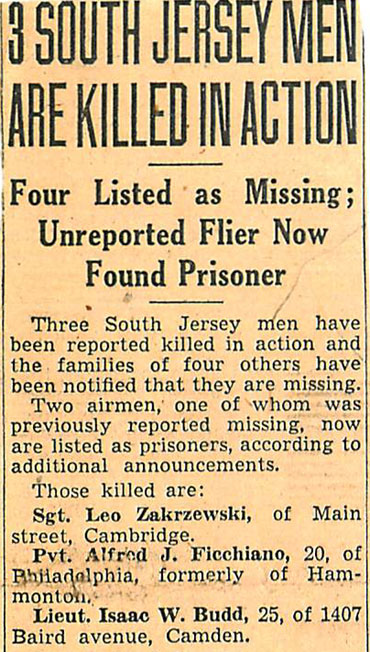
|
Camden Courier-Post Isaac
W. Budd
|
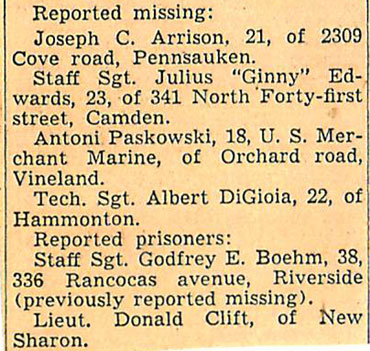
|
|
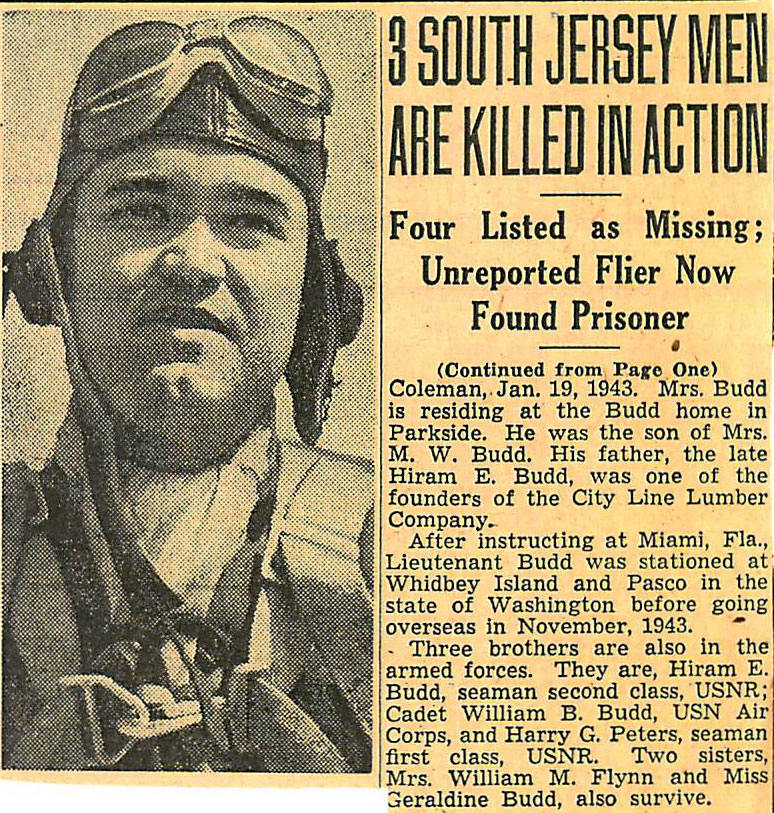
|
|
| Camden Courier-Post - April 21, 1944 | ||
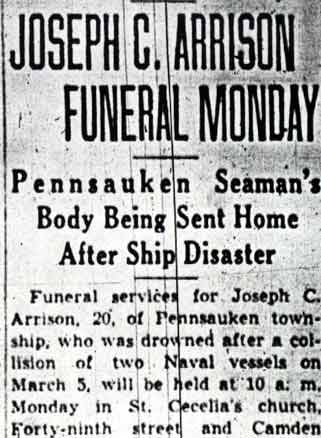
|
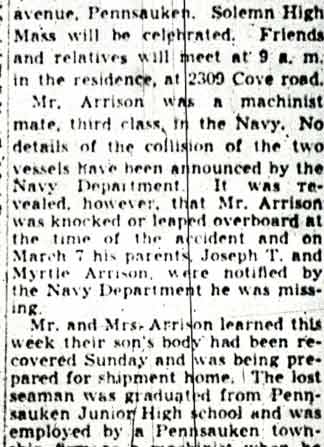
|
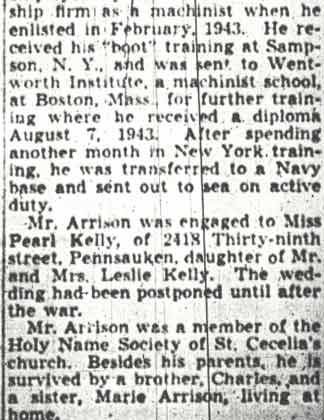
|
|
|
|
From the War Diary of the USS TWIGGS DD-591 |
||||||||||||||||
|
CONFIDENTIAL UNITED STATES SHIP TWIGGS(DD591) Sunday 5 March 1944 Zone description- Plus 4
Commanding Officer.
|
|
From the War Diary of the USS TWIGGS DD-591 |
|
DD591/A12-1 U.S.S. TWIGGS (DD 591)
jg Serial 027-44
From:
Th
e
Commanding Officer
Mar c h 2, 1944. Operating under COTCLant a s Training Ship for D D nucleus and balan c e crews at Naval Operating Base, N orfolk, Virginia. Acting as Training Ship along�side or making daily crui s e s with training crews aboard in lower C hesapeake area . March 3, 1944. Operating under COTCLant as Training Ship for DD nucleus and balance crews at Naval Operating Base, Norfolk, Virginia. Acting as Training Ship along-side or making daily cruises with training crews aboard in lower Chesapeake area* March 4, 1944. Operating under CO'TGLant as Training Ship for DD nucleus and balance crews at Naval 0perating Base, Norfolk, Virginia. Acting as Training Ship along�side or making daily cruises with training crews aboard in lower Chesapeake area. March 5, 1944. Underway at 0848 from pier 5, Naval Operating Base, Norfolk, Virginia for daily training cruise with trainees aboard. Captain FELLOWS had the conn with the navigator on the bridge. H.M.S. PREMIER crossing the slip necessi�tated stopping all engines. At 0855 again backing into the channel. At 0858 S.S. JAMES ELWOOD JONES proceeding up the channel and having previously sounded one blast at three different times. Sounded the danger signal. All engines put ahead emergency full. At 0859 the S.S. JAMES ELWOOD JONES collided with this ship at frames 184 to 192 on the port side flooding compartment C-205-L. Collision quarters sounded. 0900 All engines stopped. March 6, 1944* (Continued) 0901-ir let go port anchor* 0905 Having made emergency tests and shifted steering control aft anchor aweigh and underway with pilot at the conn and assisted by the tug PEERLESS returning to south side of pier 6, Naval Opera�ting Base, Norfolk, Virginia. 0924 Moored port side to Berth 58, pier 5, Naval Operating Base, Norfolk, Virginia. At 0931 secured from collision quarters* All trainees disembarked* 0935 Preliminary medical report showed following men injured; SMITH, Jack R., 627-46-39, MM3c, USNR; MERRITT, R.B., 828-51-05, Fie, US�; WINWARD. L.A., 662-OS-42, MM3c, USNR; GATER, Norman (n), 709-69-36, Fie, USNR; and COOKSEY, B.H., 845-98-50, Fie, USNR. 0945 Quarters being held for muster, ARRISON, Joseph Charles, 817-26-11, MM3c, V-6 USNR SV only absentee not accounted for. No trace of ARRISON found subsequently. At 0954 MERRITT, R.B., 828-51-05, Fie, USNR and SMITH, Jack R., 627-46-39, MM3c, USNR were transferred to the Naval Hospital, Naval Operating Base, Norfolk, Virginia* At 1020 Vice Admiral SHARP and members of staff came aboard leaving after viewing the damage. At 1030 with the captain at the conn underway from Naval Operating Base, Norfolk, Virginia enroute to the Norfolk Navy Yard, Portsmouth, Virginia for repairs. At 1230 moored in Berth 7, Norfolk Navy Yard, Portsmouth, Virginia, going into dry-dock at 1545. March 6, 1944. Dry-docked as before. Captain MOEN, USN acting as a board of investigation by order of Comlnch came aboard and convened the board at 2030 to inquire into the collision and adjourned at 2315. March 7, 1944 Dry-docked as before March 8, 1944. Dry-docked as before March 9, 1944 Dry-docked as before. 0900 GOTCLant board of investigation. Captain MacINTOSH, USN, senior member, convened on board to investigate damage caused by the collision. The board adjourned at 1005. |
|
USS Twiggs
(DD591) The second Twiggs (DD-591) was laid down on 20 January 1943 at Charleston, S.C., by the Charleston Navy Yard; launched on 7 April 1943; and commissioned on 4 November 1943, Comdr. John B. Fellows, Jr., in command. Following a shakedown cruise to Bermuda in December 1943, Twiggs operated out of Norfolk as a training ship until 12 May 1944, and proceeded, via the Panama Canal and San Diego, to Hawaii. After arriving in Pearl Harbor on 6 June 1944 and throughout most of July, Twiggs worked out of Eniwetok. On 19 August, she returned to Pearl Harbor. On 15 September, in preparation for the assault on Leyte, Twiggs departed Pearl Harbor as a member of Destroyer Squadron 49. She departed Seeadler Harbor on 14 October. Arriving off Leyte on 20 October, Twiggs helped to provide antiaircraft protection for the transports during the landings. Twiggs departed Leyte on 25 October, steamed via Mios Woendi Island to Manus, and arrived at Seeadler Harbor on 1 November. On 10 December, Twiggs left Kossol Roads, between Peleliu and Angaur, with a task force bound for the occupation of Mindoro Island. Luzon was the key to the liberation of the Philippines. From December 13 through the 17th, Twiggs provided antiaircraft cover for the force as it steamed through Suriago Strait and the Mindoro Sea. Late in 1944, Japan began organized and concerted use of kamikazes. On 13 December, a Japanese suicide plane crashed into Haraden (DD-585). Twiggs aided the severely damaged destroyer, fighting fires and treating casualties. On 4 January 1945, Twiggs rescued 186 survivors of Ommaney Bay (CVE-79). Twiggs joined Task Force 54 on 10 February. On 16 February the force arrived off Iwo Jima. On the 17th, a suicide plane attack on Twiggs resulted in a close call when the plane, in an obvious attempt to crash into the destroyer, crossed her fantail before hitting the water off her port beam and sinking without exploding.
On 25 March 1945, Twiggs arrived off Okinawa to take part in the pre-invasion bombardment. On 28 April, a day of heavy air activity, a kamikaze splashed close aboard Twiggs . Bomb blast and fragmentation from the splashed airplane and bomb blew in the hull plating between the main and first platform deck causing structural damage. The underwater body was dished in, and the starboard propeller was bent. On that date, 10 men were killed and 15 wounded. In June, the battle for Okinawa was drawing to its close. Twiggs continued radar picket duties in the western fire support area and supported strikes on Iheya Shima and Iheya-Aguni with pre-landing bombardment and gunfire support. On 16 June, Twiggs was on radar picket duty off Senaga Shima in the western fire support area. At 2030, a single, low-flying plane dropped a torpedo which hit Twiggs on her port side, exploding her number 2 magazine. The plane then circled and completed its kamikaze, mission in a suicide crash. The explosion enveloped the destroyer in flame; and, within an hour, she sank. Despite the hazard of exploding ammunition from the blazing Twiggs , 188 survivors including 39 men who were wounded were rescued from the oily waters. Among the 126 dead was her commanding officer, Commander. George Philip Jr. Twiggs was struck from the Navy list on 11 July 1945; and, in 1957, her hulk was donated to the government of the Ryukyu Islands. Twiggs received four battle stars for World War II service.
|
By the third week in June the battle for Okinawa was drawing to a bitter end. Implacably the forces of General Buckner were closing in on the remnant regiments of Ushijima's 32nd Army, standing in the craggy hills of southern Okinawa with their backs to the sea. The Navy, too, closed in. Shore bombardments were called for as the cornered Japs neared land's end. These were dangerous assignments, for the enemy forces were dying hard. And the Kamikaze flyers were setting the pace. During the evening of June 16, the rabid airmen struck again. One of them struck at a destroyer which was standing offshore for bombardment duty - - the USS Twiggs, captained by Commander George Philip. Time: about 2030. The plane, a "Jill" torpedo bomber, dropped down out of the dusk like a thunderbolt. When detected, it was less than 1000 yards from the destroyer, and coming with the velocity of a bullet. An unleashed torpedo knifed into the water and raced at the ship. Before Twiggs could be swung away, the torpedo ripped into the No. 2 magazine. Then the plane crashed into the ship aft. Torpedo explosion - magazine explosion - aircraft explosion - the triple blasting tore the destroyer's frame and sent sheets of fire throughout her superstructure. Damage controlmen never had a chance. And in a instant, the ship was a furnace, with men fighting their way topside to escape roasting heat and suffocating smoke, only to find the deck a burning griddle. All able hands rallied to rescue the wounded, battle the fire, and save the ship, but the the Twiggs had become a death-trap. Thirty minutes after the Kamikaze smash, the ship's after magazine blew up with a shattering detonation. The vessel plunged immediately. Down with her she took 18 of her 22 officers. One hundred and sixty-five men were lost with the ship. Down with the destroyer went her captain, Commander Philip. The survivors drifted in clots on the sea, and waited for help to come. Presently the destroyer Putnam arrived to pick up these latest victims of the "Divine Wind." Many of the 131 who were recovered needed surgery and hospitalization. The three surviving officers were among the wounded: the Twiggs disaster was one of the few in which every officer in the embattled ship was either killed or injured. She was the twelfth destroyer downed off Okinawa, and she was downed in the twelfth week of the campaign. One destroyer a week, and a destroyer-escort in addition. "Operation Iceberg" and the Japanese Kamikaze program would never be forgotten by the US Navy's destroyer men. But the campaign was not over. Okinawa had yet to be secured. |
RETURN TO CAMDEN COUNTY WAR DEAD INDEX